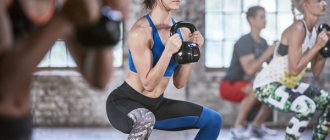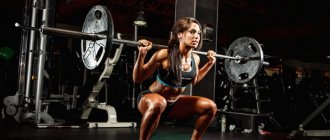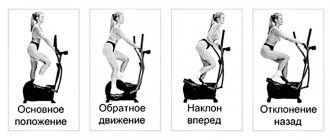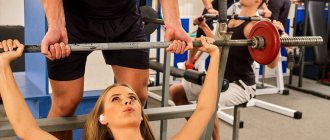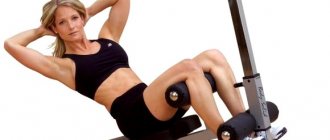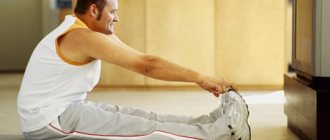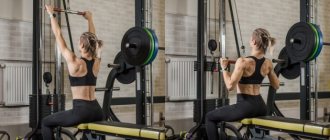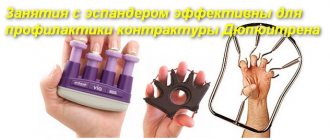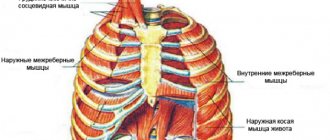The popularity of fitness and bodybuilding in Russia has approximately quadrupled since the early 2000s. At least approximately one in five people is somehow connected with iron sports. Today we won’t talk about diets, because most people have no idea how to properly organize their time in the gym. This means that after spending a lot of time training, a person can do one traumatic exercise after another. Next, you will learn how to effectively manage your exercise time and what exercises to avoid.
Smith machine squats
Linear squats, which are performed in a Smith machine, are an unnatural movement and, frankly, dangerous. The angles you take during this exercise have an extremely negative impact on the condition of your joints, and there is also a risk of injury to the lumbar region. Replace this exercise with regular squats with a barbell on your shoulders.
The most useless machines in the gym. Never go near them!
A modern gym has a million different exercise machines. “Soviet Sport” has chosen the most useless of them, the practice of which must be prohibited on pain of death.
1.Hack squat machine
https://youtu.be/OoWO0o88yeo
What is this:
a device that allows you to simulate regular squats. You stand on the platform, with your back to the counter, with a double lever (shoulder pad) on your shoulders - and begin to squat. The weight in the structure moves back and forth on a skid.
It is believed that hack squats remove most of the load on the spine - due to the fact that the back is fixed in the rack, and the platform with the weight moves in the same plane.
Uselessness:
The load on the spine in the hack trainer is really less. At the same time, the knee joints literally become numb from the hack simulators. Due to the straight back leaning against the support, the knees take on an unnatural and dangerous load - there is a high risk of injury. At the same time, there are no special advantages of hack squats over regular squats.
What to replace:
squats. They will be heavier, but many times more effective than the “trainer options”. Learn the correct squat technique, start with light weights and gradually move forward.
2. Leg press machine
https://youtu.be/HAPWTGpOCgk
What is this:
a machine that almost certainly exists in every hall. You lie with your back on the bench, place your feet on the platform above your head, and begin to bend and straighten them. Another “alternative” version of squats.
Uselessness:
In the modern fitness industry, it is customary to treat the leggy exercise machine with caution. This is due to the heavy load on the lower back and the unnatural angles of the body that it creates. When creating individual programs, instructors try to do without bench presses in the simulator and replace them with free weights. However, it is often continued to be used by “old school” bodybuilders.
Read more on the “Soviet Sports” website: what to do to prevent sore legs after squats
The Huffington Post devoted an entire article to analyzing the negative aspects of the leg press in the exercise machine. “The thigh muscles are perhaps the strongest muscle group in the human body. So when you get on the machine, you have to lift heavy weights so that your muscles receive adequate stress, says BG Gaddour, an expert for the publication and a person who has been included more than once in lists of the fittest people on the planet. – The problem is that all this weight will fall on your lower back, which is under pressure. The risk of injury is very high. Let’s throw our feet out of our program!”
What to replace:
goblet squats - front squats
3. Leg raiser
https://youtu.be/7it8w9Mh5Qo
What is this:
a machine in which you, while sitting, bring and spread your hips. It is popular with girls who believe that this way they can add roundness to their hips, work out the lateral surface of the buttocks - and remove fat from these places. Sometimes men are also seen using the simulator (for the same purposes).
Uselessness:
Seated hip extensions are potentially traumatic. The muscles and ligaments of the hip joint are forced to work in unnatural angles. This can lead to strains, ruptures, and inflammation of the ligament of bone joints.
The issue of burning fat on the thighs by bringing the legs together is also controversial. 20-25 minutes of running will burn much more efficiently.
What to replace:
squats with jumping, lunges with one leg on a support, running training.
4. Seated chest press machine
https://youtu.be/Sd4Eo_H8QJo
What is this:
a device in which you push two levers in front of you while sitting. Used to work the pectoral muscles.
Uselessness:
Experienced athletes use this simulator to separate the upper, middle and lower bundles of the pectoral muscles - to achieve the so-called “striation” of the chest. Beginners, who often replace the classic bench press with a bench press in a machine, do not need to approach this machine.
Read more on the “Soviet Sport” website: what to do if you are crushed by a barbell
Firstly, they still have nothing to separate - first you need to increase the total mass of the pectoral muscles. Secondly, as Ted Coleman, coach of the cult powerlifting gym Metroflex, notes, the machine not only does not grow mass well, it also contributes to incorrect distribution of the load. Often for beginners, the strong arm takes on most of the load and presses the weight better, while the weaker side lags behind. This leads to the reinforcement of the wrong movement pattern and will subsequently make it difficult for you to work with the classic bench press.
What to replace:
The bench press on a horizontal bench is an exercise that is called the main one for the pectoral muscles. Add to it bench presses and incline barbells and flyovers to stretch the pectoral muscles.
5. Exercise machine for oblique abdominal muscles
https://youtu.be/SVYf1Ak5RNk
What is this:
machine for turning the torso - you sit and turn your upper body left and right, lifting the weight.
Uselessness:
It is believed that the machine is needed to work the oblique abdominal muscles, but what actually happens? The pelvis is fixed while the upper torso is twisted. The wide range of motion in the simulator stretches the vertebrae, the lower back begs for mercy - it’s good if you stop before an injury occurs.
What to replace:
planks - frontal and side, will strengthen the core and abs muscles better than this infernal machine.
Leg extension in the simulator
This exercise is dangerous because such an amplitude of movement is unnatural. Evolution did not expect the human quadriceps to work in isolation with the knees above waist level. This exercise is great for working your quads, but it puts a lot of stress on your knee joint. Better replace it with front squats.
Ab crunches or crunches
98% of those involved perform this exercise by moving the pelvis, and therefore the iliopsoas muscles, without feeling or getting the proper effect from the crunch. The correct technique is based on flexing the spine with fixation of the pelvis on the floor or hanging relative to the lower back.
You can improve the exercise quite simply - you need to press your lower back and pelvis to the floor (this will reduce the range of motion, but increase the efficiency at least twice). By the way, an excellent replacement for this exercise can be the classic plank with a neutral body position (tense stomach and upper back, relaxed legs, shoulders and neck).
Leg abduction in the simulator
This unit was created to tone the muscles of your inner and outer thighs. Many people believe that this exercise will locally burn fat from your legs, but this is not true. This exercise is too isolated and should not be done if you are not at a high level of training. If you need to work your legs, do squats.
Curtsy lunges
It is generally accepted that this exercise is aimed at working the gluteal muscles and is highly effective, but this is not so. When performing such a movement, damage can be very serious. This type of lunge puts a lot of strain on the cruciate ligaments (one of the main stabilizers of the knee joint). When performing these lunges, the ability to take a lot of weight is excluded, so curtsy-style lunges are the most useless exercise option.
Read more about the curtsy exercise →
Seated torso curl
Not only is this exercise extremely difficult to replicate, but it also harms your lower back. The human body is not designed to work the back muscles in this position; this is not provided for by evolution, and therefore is dangerous. If we consider an analogue, then experts recommend starting to do deadlifts on straight legs. If you are not underdeveloped, then start with small dumbbells.
Recumbent exercise bike
This simulator makes the work ineffective due to the initial angle of flexion of the hip joint, which does not provide the full amplitude of activation of the leg muscles (buttocks, back and front of the thigh), and the intensity in a practically lying position is very low (even when the appropriate settings are installed).
A vertical (regular) exercise bike or a cycle trainer (fully simulating a bicycle) works much more effectively with the ability to replace track speed loads and uphill climbs. They put a load on the whole body, add stabilization to the back, and the legs work in full range.
Leg curls in a lying machine
Another problem with this simulator is that the knee joint moves in an unnatural position, which can injure it. It is safe to work with very light weights. If you're doing a leg workout, barbell curls can be a great way to warm up.
Hyperextension with round back
This exercise is aimed at training the muscles of the lower back, buttocks and hamstrings, but this does not give the best effect and contributes to pinching of the piriformis muscle, and this can lead to serious consequences.
Read more about gluteal extension →
BOSU Balance Trainer
This simulator is usually used for balance training under the supervision of a trainer. Some guys lock their elbows on it and do biceps curls or do regular squats. Thus, they create unstable support under them, which is fraught with injury. It is not recommended for beginners to use this simulator.
Vertical block row for the head
The exercise uses the latissimus dorsi, deltoid muscles, and biceps. The practitioner grabs the handle and pulls it behind his head, then returns to the starting position.
However, it is dangerous for the shoulder joints, the movement behind the head is not natural, the end of the scapula rubs against the tendon. This subsequently leads to pain. Stanislav Lindover, European champion in classical bodybuilding, master of sports in bodybuilding, in his book “MegaMass. A set of training, nutrition and discipline to achieve an ideal figure” writes the following about this exercise:
The head position in this exercise is somewhat unnatural. If you have flexible shoulder joints, include it in your training.
If a person does not have flexibility in the shoulder joints, there is no point in including this exercise in the training plan.
What to replace: chest thrust. The effectiveness is not reduced, but the risk of injury or discomfort is minimal.
How to unload the spine?
Athletes who have suffered back injuries should avoid compressing the intervertebral discs. For example, it is recommended to replace deadlifts with more physiological hyperextension. When not only the lower back, but also the posterior muscles of the thigh and buttocks are involved in extension, the vertebrae are partially released from compression.
However, with extrusion on a thin stem, even a slight hyperextension of the lumbar spine can lead to pinching or rupture of the intervertebral disc, so any hyperextension is prohibited. In such cases, it is worth mastering the quadriplex - simultaneous lifting of the outstretched right arm and left leg and vice versa parallel to the floor from a position on all fours.
Paradoxically, many dangerous exercises for the spine are performed with a fixed back. In particular, when doing leg presses and lifting the lower extremities while lying down or in a machine with support on the forearms, stabilizing muscle structures are “turned off”, which could balance the twisting of the pelvis and increased traction of the lumboiliac muscle, which threatens displacement of the vertebrae. If you experience pain in the lower back or sacrum, switch to less traumatic planks, squats, and lunges.
Bicycle crunches and heavy bending are not the best methods for working the oblique abdominal muscles due to overstrain of the anterior intervertebral discs. If there is a curvature of the spinal column in the lumbar region, the exercise is definitely contraindicated. If you are afraid of complications of osteochondrosis, master side planks and ring crunches.
The benefits of rotating the body in the simulator are also very doubtful. The opposite direction of rotation of the pelvis and chest creates the prerequisites for the appearance of subluxations and hernias in the lumbar region. An alternative way to work the oblique abdominal muscles is to do rows with crunches on the upper block.
Results
In fact, the top may contain more exercises; its list could be supplemented by plyometric and some cardio exercises that provide impact on the joints and spine. Therefore, we looked at the most technically dangerous exercises in machines and with free weights, as well as injuries that most often occur among beginners and professionals when the technique is not followed.
https://youtu.be/kaqcBKiQzEQ

